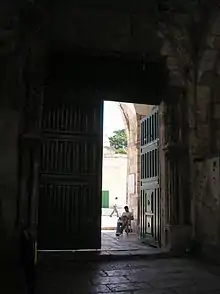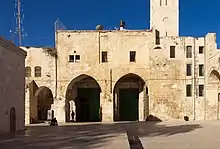
The Chain Gate (Arabic: باب السلسلة, Bāb as-Silsila) is one of the gates to the Al-Aqsa Mosque compound on the Temple Mount in the Old City of Jerusalem. It was previously known as David's Gate.[1] As it was named in the early Islamic period Bāb Daud which means David's Gate.[2][3][4] It was also known as Bāb al-Maḥkama (باب المحكمة Gate of the Law Court), named after the nearby Tankiziyya (the Maḥkama).[5]
Description and history
Its rectangular doors are 4.5 m high. There is a small opening large enough for one person to pass through when the gate is closed.[6]
It is known today as Bab Al-Silsilah and Bab Al-Sakinah. It was considered the most beautiful of the Al-Aqsa mosque gates. It has two entrances, the northern one is called the Gate of the Sakinah (Tranquility Gate) and the southern one is called the Gate of Al-Silsilah (Chain Gate).[7][2] The entrance to the Gate of the Sakinah is closed and is not opened except for necessity. It worth to notice that the closure of the northern gate happened a long time ago, where the historian Al-Omari ( 746 AH /1345 CE ) mentioned that the northern gate had been closed.[8] While the entrance to Bab Al-Silsilah is open. And it has an opening large enough for one person to enter when it is closed.[7] According to Nasir-i-Khusraw, in order to reach the gate one had to pass through the market in the eastern section of the city and the gate itself had two openings that led into a large hall.[1] Its construction was renewed in the Ayyubid period 1200 CE 600 AH during the reign of the great King Issa.[7][4]
Its twin gate

Bāb as-Sakīna is the northern half of the double gate that includes the Chain Gate.[9][10] It is always closed.[11] Its names:
- Bāb as-Sakīna (باب السكينة): the Gate of the Divine Presence,[12] the Gate of God's Presence,[13] or the Gate of Tranquillity.[14] (cf sakīna & سكينة)[N 1]
- Originally Bāb as-Sakīna was the name of another gate at the Southern Wall, possibly one of the Double Gate.[10]
- Bāb as-Salām (باب السلام): the Gate of Peace.[14][19]
Environs
The southwestern part of the Muslim Quarter is outside the gate. The neighborhood (Bāb as-Silsila / Bāb al-Silsila) is named after the gate.[20] Chain Gate Street leads toward a market (Sūq Bāb as-Silsila) and eventually the gate.[21] Once inside the compound, one can immediately see the Dome of Moses (south) and Fountain of Qasim Pasha (north, also named Sabīl Bāb al-Maḥkama, after the gate). The southwestern colonnade is the closest of the Mawazin.
The Chain Gate Minaret is just north of it. And north of that, one finds the al-Ashrafiyya Madrasa. South of the gate, and part of the compound wall, one sees the at-Tankiziyya Madrasa.[6]
Archaeology
The results of archaeological excavations along the western wall of Al-Aqsa Mosque have shed some light on the history of this gate. Where it confirmed that it was located in an elevated position above the main street located adjacent to the western wall, which is the reason for building the bridge leading to Al-Aqsa Mosque through this gate, and based on that, it can be believed that this gate was built at the same time as the bridge that was built in the early Islamic period.[2]
Chain Gate after 1967
This Gate is one of the three Gates that open alone for worshipers at the prayers of Isha'a and Fajr since 1967. It is the closest gate leading to the Al-Qibli Musalla hall after the closure of the Maghriba Gate by the Israel. It is also the closest to the Al-Buraq Wall.[22]
See also
- Dome of the Chain, also in the compound
References
- 1 2 Prawer, Joshua; Ben-Shammai, Haggai (November 7, 1996). "The History of Jerusalem: The Early Muslim Period (638-1099)". NYU Press – via Google Books.
- 1 2 3 Al-Ratrout, H. (2004). The Architectural Development of Al-Aqsa Mosque in Islamic Jerusalem in the Early Islamic Period: Sacred architecture in the shape of ‘The Holy’. Al-Maktoum Institute Academic Press. pp.349-358.
- ↑ Al-Hanbali, M. (1968). الأنس الجليل بتاريخ القدس والخليل[The honorable amiability in the history of Jerusalem and Hebron]. Al-Haydari Press Publications.
- 1 2 Al-Jallad, I. (2017). معالم المسجد الأقصى تحت المجهر [Al-Aqsa Mosque landmarks under the microscope]. Baytul Maqdis Center for Literature
- ↑ Necipoglu, Gülru (2009). "The Dome of the Rock as Palimpsest". Muqarnas. Leiden: Brill. 25: 20. ISBN 978-900417327-9.
Gate of the Chain […], also known as Gate of the Law Court (bāb al-maḥkama) after the Shari'a Court to its south
- 1 2 "باب السلسلة". qudsinfo.com. Retrieved 2020-06-15.
- 1 2 3 Maruf, A. & Marei, R. (2010). Atlas Ma’alem Al-Masjid Al-Aqsa [Atlas of Al-Aqsa Mosque landmarks]. Al-Fursan institution.
- ↑ Al-Omari, S. (n.d.). مسالك الأبصار في ممالك الأمصار (Vol. 2).
- ↑ Hawari, Mahmoud (2007). Ayyubid Jerusalem (1187-1250). Archaeopress. p. 74. ISBN 978-1-4073-0042-9.
Bāb al-Silsila / Bāb al-Sakina […] The twin gate is bounded to the north by the Baladiyya Madrasa, the Ashrafiyya Madrasa and the Bāb al-Silsila Minaret, to the east by the West Portico
- 1 2 Grabar, Oleg (2005) [First published 1965]. Jerusalem (PDF). Ashgate. pp. 52–54. ISBN 978-0-86078-925-3. Archived from the original on May 18, 2022.
the Bab al-Sakina, shown first to have been on the southern side – probably one of the sides of the Double Gate – and migrating to the northern part of the Bab al-Silsila (on the western side of the Haram) at some undetermined date, but probably after the Crusades when the southern entrances to the Haram were blocked off […] [p. 54:] the double gate Bab al-Salam-Bab al-Silsila […] Such is already the list provided by Mujir al-Din, with the substitution of Bab al-Sakina for Bab al-Salam […] The same number is already present in al-'Umari (c. 1350), with, curiously, the name Bab al-Salam for the northern half of the double gate.
- ↑ "باب السلسلة - أرشيف المسجد الأقصى المبارك". alaqsa-archive.com (in Arabic). Retrieved 2020-06-15.
أما الباب على اليمين فهو مغلق دائماً واسمه باب السكينة . [As for the door on the right, it is always closed, and its name is Bāb as-Sakīna.]
- ↑ Prawer, Joshua; et al. (1996). The History of Jerusalem: The Early Muslim Period (638-1099). NYU. p. 429. ISBN 978-0-8147-6639-2.
Bāb al-Sakīna […] Gate of the Divine Presence, see Shekhina Gate.
- ↑ "Bab al-Silsila". Institute for International Urban Development (I2UD).
- 1 2 Warren, Charles (1878). The Survey of Western Palestine. Committee of the Palestine Exploration Fund.
through a handsome double gate. The southern gate is called the Báb as Silsilé (Gate of the Chain), the northern Báb as Salâm (Gate of Peace). [footnote:] Mejr ed-Din states that the gate was built in A.H. 877 (1492-3 A.D.), and he calls the Báb as Salâm the Gate of Tranquillity (Sekiné).
- ↑ Murphy-O'Connor, Jerome (2008). The Holy Land: An Oxford Archaeological Guide. Oxford: OUP. ISBN 978-0-19-164766-6.
The left bay (north) is Bab al-Sakina, 'the Gate of the Dwelling', and the right Bab al-Silsila, 'the Gate of the Chain'.
- ↑ Heath, Peter (2010). Allegory and Philosophy in Avicenna (Ibn Sina): With a Translation of the Book of the Prophet Muhammad's Ascent to Heaven. University of Pennsylvania Press. p. 182. ISBN 978-0-8122-0222-9.
it is this (force) which is called in Arabic the Indwelling (al-sakîna) and the Holy Spirit (rûḥ al-quds).
- ↑ Zawanowska, Marzena, ed. (2021). The Character of David in Judaism, Christianity and Islam. BRILL. p. 140. ISBN 978-90-04-46597-8.
the indwelling of the Divine Presence (Ar. Sakīna) [among them]
- ↑ Wehr, Hans (1979). A Dictionary of Modern Written Arabic. Otto Harrassowitz. p. 488. ISBN 978-3-447-02002-2.
سكنة sakina, pl. -āt: residence, home
- ↑ Wilson's map (1865): "Bab as Salâm (Gate of Peace)"
- ↑ Büssow, Johann (2011). Hamidian Palestine: Politics and Society in the District of Jerusalem 1872-1908. BRILL. p. 152. ISBN 978-90-04-21570-2.
The Silsila neighbourhood owed its name to one of the gates to the Haram al-Sharīf, the Chain Gate or Bāb al-Silsila.
- ↑ Nazmi, Jubeh (2021). "Tariq Bab al-Silsila" (PDF). Jerusalem Quarterly. Institute for Palestine Studies (87): 105–125.
- ↑ Maruf, A. & Marei, R. (2010). Atlas Ma’alem Al-Masjid Al-Aqsa [Atlas of Al-Aqsa Mosque Landmarks]. Al-Fursan institution.
